Nara
Japan's first permanent capital was established in the year 710 at Heijo, the city now known as Nara. As the influence and political ambitions of the city's powerful Buddhist monasteries grew to become a serious threat to the government, the capital was moved to Nagaoka in 784.
Nara is located in the Kinai plain, less than one hour from Kyoto and Osaka. Due to its past as the first permanent capital, it remains full of historic treasures, including some of Japan's oldest Buddhist temples.
Todaiji
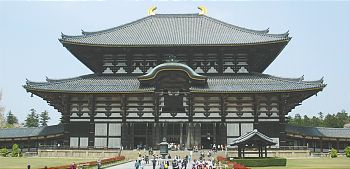
Todaiji ("Great Eastern Temple") is one of Japan's most famous and historically significant temples and a landmark of Nara.
Todaiji was constructed in 752 as the head temple of all provincial Buddhist temples of Japan and grew so powerful that the capital was moved from Nara to Nagaoka in 784 in order to lower its influence on government affairs.
Not only is Todaiji housing Japan's largest Buddha statue (Daibutsu), but it is also the world's largest wooden building, even though the present reconstruction of 1692 is only two thirds of the original temple's size.
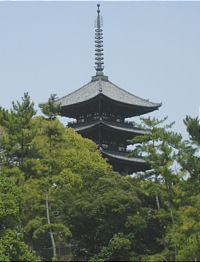
Kofukuji
Kofukuji used to be the family temple of the Fujiwara, the most powerful family clan during much of the Nara and Heian Periods.
The temple was established in Nara at the same time as the capital in 710. At the height of Fujiwara power, the temple consisted of over 150 buildings.
Today, a couple of buildings of great historic value including a three and a five storied pagoda remain. The five storied pagoda is one of Japan's tallest and the symbol of Nara.
Kofukuji's Treasure House exhibits part of the temple's great art collection.
Kasuga Taisha
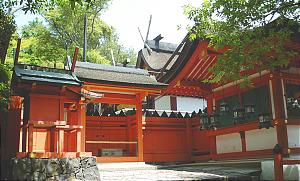
Kasuga Taisha is Nara's most celebrated shrine. It was established at the same time as the capital and dedicated to the deity responsible for the protection of the city. Kasuga Taisha was also the tutelary shrine of the Fujiwara, Japan's most powerful family clan of most of the Nara and Heian Periods.
Like the Ise Shrines, Kasuga Shrine had been periodically torn down and rebuilt every 20 years for many centuries. In case of the Kasuga Shrine, however, that Shinto custom was discontinued at the end of the Edo Period.
Kasuga Taisha is famous for its many lanterns which were donated by worshippers. The many bronze lanterns within the shrine and the hundreds of stone lanterns lining the shrine's approach are lit on the occasion of the Lantern Festivals in February and August.
Horyuji
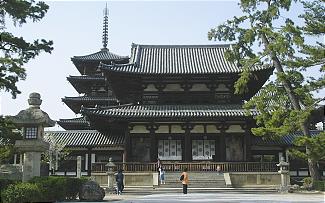
Founded by Prince Shotoku, who is attributed with having introduced Buddhism to Japan, Horyuji is one of Japan's oldest temples. Its main hall, five storied pagoda and central gate, all located in the temple's Saiin Garan (Western Precinct) and dating from the 7th century, are the world's oldest surviving wooden structures.
Next to the Saiin Garan is the newly constructed Daihozoin, a hall that exhibits a part of the temple's art collection. The main attraction of the Horyuji's Toin Garan (Eastern Precinct) is the Yumedono, the Hall of Visions.
In 1993, Horyuji was designated a UNESCO world heritage site. Unlike many other historic attractions in Japan, Horyuji is wheelchair accessible and provides pamphlets in various foreign languages.
Horyuji is located about 12 km outside of central Nara.
By train: From JR Nara Station, take the frequently departing Yamatoji Line to Horyuji Station (12 minutes). From there, it is a 20 minute walk or 5 minute bus ride to the temple.
By bus: From JR or Kintetsu Nara Station, take bus number 60 which takes about 40 minutes to Horyuji-mae. Alternatively, take bus number 52, 97 or 98 which take about 15 minutes longer than bus number 60.
Yakushiji
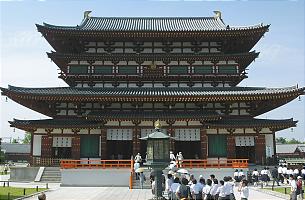 | 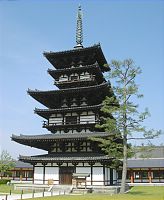 |
Yakushiji was constructed by Emperor Temmu in the late 7th century for the recovery of the emperor's sick wife. One of Japan's oldest temples, Yakushiji has a strictly symmetric, Chinese style layout, with the main and lecture halls standing on a central axis, flanked by two pagodas.
The main hall was rebuilt in the 1970s after being destroyed by fire, and houses the Yakushi trinity, a masterpiece of Japanese Buddhist art. The east pagoda is the temple's only structure to have survived the many fires and dates from 730. It appears to have six stories, but is in fact three storied, like the west pagoda.
Toshodaiji
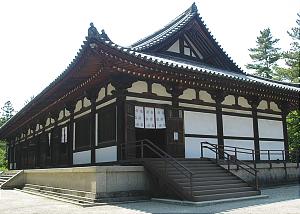
Toshodaiji was founded in the year 759 by Ganjin, a Chinese priest who was invited to Japan by the emperor in order to train priests and improve Japanese Buddhism.
Ganjin's tomb and the Miedo, a hall which stores a famous wooden statue of Ganjin, are located on the temple grounds. The statue, however, is displayed to the public only once a year on June 6, the anniversary of Ganjin's death.
The temple's lecture hall (kodo) was moved to Toshodaiji from the Nara Imperial Palace, and is now the only surviving building of the former palace. Toshodaiji's main hall (kondo) is currently being renovated until 2009.